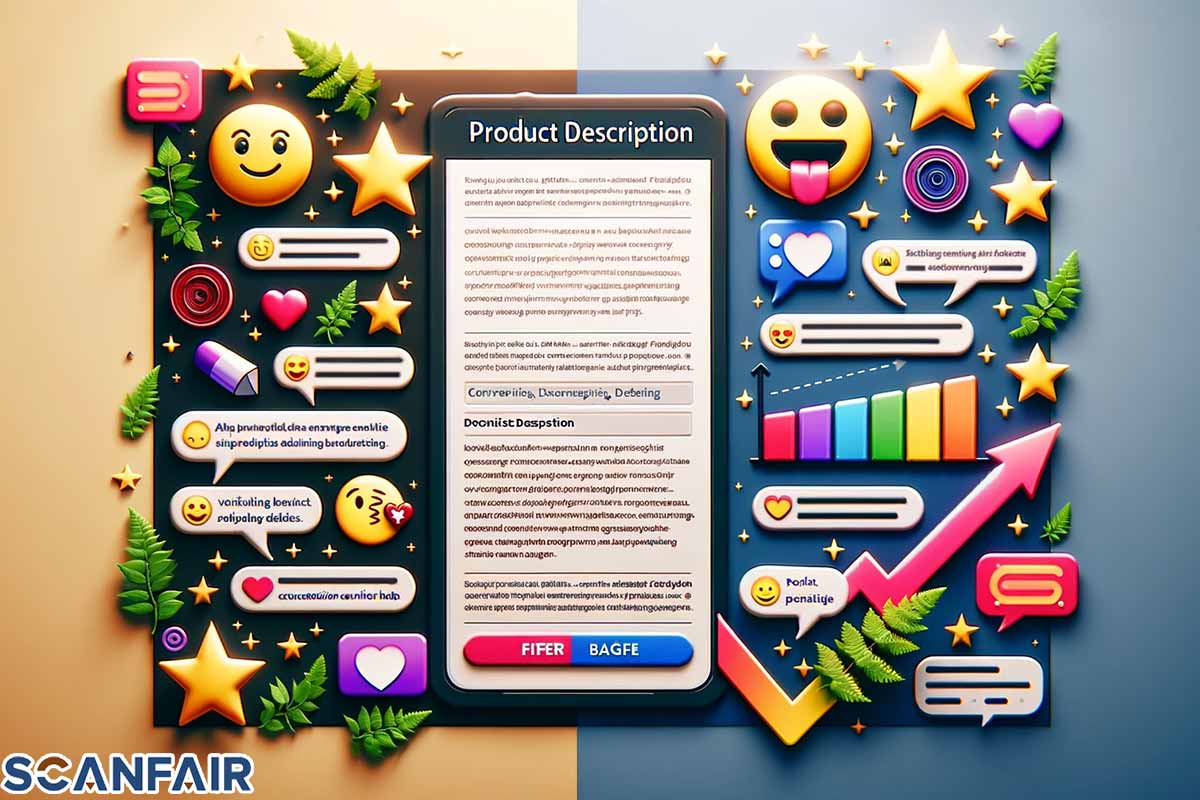In the bustling online marketplace of Amazon, the power of a product description cannot be overstated. This crucial element acts as the bridge between potential customers and the products they seek, offering a unique opportunity to communicate the value, function, and necessity of an item. For sellers utilizing Fulfillment by Amazon (FBA), mastering the art of crafting these descriptions is essential. A well-crafted description goes beyond mere facts; it tells a story, highlighting the benefits and solving the problems that a customer might face. It’s not just about what the product is, but how it fits into the buyer’s life, making it irresistible. With the right approach, product descriptions can significantly enhance visibility, drive sales, and create a loyal customer base. As we delve into the nuances of effective description writing, remember, it’s not just about selling a product; it’s about creating an experience that resonates with your audience. In the essay, we at Scan Fair will talk more about this topic.
Understanding Your Target Audience
Identifying and understanding your target demographic: The success of an FBA product hinges on how well you understand the people you’re selling to. This process begins with demographic analysis—age, gender, income level, education, and more. But it goes deeper into psychographics, including interests, values, and lifestyle. This comprehensive understanding allows you to predict and meet the needs of potential customers more accurately. Tools like Amazon‘s own analytics, social media insights, and customer surveys can provide invaluable data for this analysis.
Tailoring your product descriptions to meet the needs and wants of your audience: Once you have a clear picture of your target demographic, customizing your product descriptions to speak directly to their desires and pain points becomes crucial. Use language that resonates with them, address their specific problems, and demonstrate how your product provides the solution. Highlight features and benefits that align with their preferences and values. The goal is to make each reader feel like the product description is speaking directly to them, making the product an irresistible addition to their lives. This tailored approach not only improves engagement but also increases the likelihood of conversion.
The Power of Keyword Research
How to perform effective keyword research for Amazon listings: Effective keyword research is foundational for maximizing visibility on Amazon’s crowded marketplace. Start by identifying core keywords related to your product, utilizing tools like Amazon’s own search bar autocomplete, keyword research tools specifically designed for Amazon, and analyzing competitors’ listings for frequently used terms. Beyond the obvious keywords, explore long-tail keywords—more specific phrases that potential customers might use when they’re closer to a purchase decision. These are less competitive and can attract more qualified traffic.
Incorporating the right keywords without keyword stuffing: Once you’ve identified your keywords, the challenge is to incorporate them into your product listings naturally. Keywords should be seamlessly integrated into titles, bullet points, and descriptions, enhancing readability rather than detracting from it. Amazon’s algorithm favors content that provides value to the customer, not just a string of keywords. Aim for a balanced approach by focusing on keyword relevance and placement. Use synonyms and variations to cover a broader range of search queries without repeating the same terms excessively, which can lead to a penalty for keyword stuffing. Remember, the primary goal is to engage your audience with clear, informative, and compelling product descriptions.
Structuring Your Product Descriptions for Maximum Impact
Best practices for structuring your product descriptions: The structure of your product descriptions plays a critical role in capturing and retaining customer interest. Begin with a compelling headline that clearly states what the product is and its key benefit. Follow this with an introductory paragraph that expands on the headline, offering a bit more detail about the product’s value and appeal. Use this section to connect emotionally with the reader, highlighting how the product can solve a problem or enhance their life.
Using bullet points and paragraphs effectively: After setting the stage with an engaging introduction, break down the product’s features and benefits into bullet points. This format allows customers to quickly scan the key selling points. Each bullet should focus on a single benefit or feature, keeping it concise and to the point. Following the bullet points, use a short paragraph to tell a story about the product, perhaps illustrating how it can be used or the impact it can have on the customer’s life. This blend of bullet points and narrative paragraphs caters to both skimmers and readers, ensuring your descriptions are accessible and appealing to a wide audience.
Writing Tips to Make Your Descriptions Stand Out
Using persuasive language to entice buyers: Crafting product descriptions that stand out requires the use of persuasive language that speaks directly to the buyer’s emotions and logical reasoning. Start by understanding the core desires and pain points of your target audience. Use active voice and powerful action verbs to create a sense of urgency and excitement. Phrases that evoke imagery and emotion can help the reader visualize the benefits of the product in their own lives. Highlight unique selling points and benefits over features, showing customers how the product will improve their lives or solve a specific problem. This approach turns a standard description into a compelling narrative that encourages the buyer to act.
The importance of clarity and conciseness in your descriptions: While persuasive language is key, clarity and conciseness are equally important. Your product descriptions should be easy to read and understand, avoiding jargon and complex language that could confuse potential buyers. Short sentences and paragraphs help maintain the reader’s attention and make the description more digestible. Focus on providing all the necessary information about the product in a straightforward manner, ensuring that the buyer can make an informed decision quickly. Clear and concise descriptions are more likely to convert browsing into sales, as they respect the reader’s time and intelligence.
Leveraging High-Quality Images and Videos
How to complement your descriptions with high-quality images and videos: Integrating high-quality images and videos with your product descriptions significantly elevates the buyer’s shopping experience. Start by ensuring that your images are clear, well-lit, and showcase your product from multiple angles to give customers a comprehensive view. Use a white or neutral background for the main images to highlight the product details. Incorporating videos that demonstrate the product in use can further bridge the gap between online shopping and the tangible in-store experience. These visuals should align with the narrative created by your product descriptions, reinforcing the key benefits and features mentioned in the text.
The role of visual content in enhancing product appeal: Visual content plays a pivotal role in capturing and retaining customer interest. High-quality images make the first impression, drawing shoppers into your listing, while videos can convey complex product features in an easily digestible format. Together, they create a dynamic, engaging presentation that enhances product appeal far beyond what text alone can achieve. Visuals provide a quick, accessible way to assess product quality and functionality, helping customers make informed purchasing decisions. By effectively utilizing images and videos, you can significantly increase conversion rates, as these elements allow shoppers to visualize the product in their lives, thus making it more appealing and desirable.
Optimizing for Mobile Users
Ensuring your product descriptions are mobile-friendly: In a world where smartphones are a primary means of internet access, ensuring your product descriptions are mobile-friendly is crucial. This means optimizing your content to be easily readable on smaller screens. Use short, concise sentences and paragraphs to improve readability. Bullet points are effective for listing product features or benefits, allowing users to quickly scan through the information. Additionally, make sure your website’s design is responsive, meaning it automatically adjusts to fit the screen size of various devices. This ensures that images, videos, and text display correctly, providing a seamless shopping experience for mobile users.
The significance of mobile optimization in today’s shopping behavior: Mobile optimization has become indispensable due to the significant shift towards mobile shopping. Consumers expect a frictionless browsing experience, where they can easily find and purchase products on their phones. Mobile-optimized product descriptions contribute to this experience by making information accessible and engaging for users on the go. Moreover, search engines like Google prioritize mobile-friendly websites in their rankings, which can enhance your visibility and drive more traffic to your listings. Given the growing prevalence of mobile commerce, optimizing for mobile users is not just an advantage—it’s a necessity for staying competitive in the digital marketplace.
Utilizing Social Proof and Reviews
Incorporating reviews and testimonials in your product listings: Reviews and testimonials are powerful tools that can significantly enhance the attractiveness of your product listings. By showcasing positive feedback from satisfied customers, you provide potential buyers with tangible evidence of your product’s value and quality. Ensure that your website or Amazon listing features a section for customer reviews and make it as easy as possible for customers to leave feedback. Highlighting standout testimonials in your product description or using a rating system can further underscore the reliability and satisfaction associated with your offerings.
How social proof can boost credibility and sales: Social proof, such as customer reviews, ratings, and testimonials, acts as a trust signal for potential buyers, demonstrating that others have purchased your product and had a positive experience. This can significantly reduce the perceived risk of buying, especially for new customers. Leveraging social proof effectively can lead to increased conversion rates, as it reassures buyers of their decision, encourages trust, and builds a sense of community around your brand. Highlighting the number of units sold, featuring user-generated content, or showcasing awards and recognitions are additional ways to utilize social proof to boost credibility and drive sales.
Common Mistakes to Avoid in Product Descriptions
Listing common pitfalls in writing product descriptions and how to avoid them: Crafting compelling product descriptions is an art that requires attention to detail and an understanding of your audience.
However, several common mistakes can detract from the effectiveness of your descriptions:
- Ignoring SEO: Failing to optimize for search engines can severely limit your product’s visibility. Incorporate relevant keywords naturally into your descriptions to improve search rankings.
- Overloading with jargon: Using too much industry-specific language can confuse potential buyers. Keep your language simple and accessible to ensure your message is clear to all.
- Being too vague: Generic descriptions that don’t highlight what makes your product unique won’t capture the interest of shoppers. Focus on specific features and benefits that set your product apart.
- Neglecting formatting: Large blocks of text are daunting and difficult to read. Use bullet points, short paragraphs, and bold headings to make your descriptions more digestible.
- Skipping proofreading: Typos and grammatical errors can undermine the professionalism of your listing. Always proofread your descriptions to ensure they are error-free.
By avoiding these pitfalls, you can create product descriptions that are not only engaging and informative but also optimized for both search engines and customer satisfaction.
Advanced Techniques for Seasoned Sellers
Using A/B testing to refine product descriptions: A/B testing, or split testing, is a powerful method for optimizing product descriptions. This involves creating two versions of your product page (A and B), each with different descriptions, to see which performs better in terms of customer engagement and conversion rates. You might vary the headline, key benefits, product details, or call-to-action to determine what resonates most with your audience. Use analytics to track metrics like click-through rates, time spent on page, and conversion rates to identify the most effective description. Regularly conducting A/B tests allows you to fine-tune your approach and improve the effectiveness of your product listings over time.
Exploring the use of AI and machine learning tools for optimization: Artificial Intelligence (AI) and machine learning tools are revolutionizing how sellers optimize their product listings. These technologies can analyze large volumes of data to identify patterns and insights that human analysis might miss. For instance, AI-powered tools can suggest the most impactful keywords, predict trends in customer preferences, and even generate or suggest improvements to product descriptions based on what has historically performed well. Leveraging these tools can help you stay ahead of the competition by continuously optimizing your listings for the highest possible conversion rates.
Tools and Software to Elevate Your Product Descriptions
Overview of tools and software that can help create compelling descriptions: The right tools and software can significantly enhance the quality of your product descriptions, making them more appealing to potential buyers. Keyword research tools like Ahrefs, SEMrush, or Amazon’s own Keyword Tool provide insights into the search terms your target audience uses, helping you to optimize your content for SEO. Grammarly and Hemingway are excellent for ensuring your descriptions are grammatically correct and easily readable. For more advanced needs, AI writing assistants such as Jasper (formerly Jarvis) or CopyAI can generate creative and persuasive product descriptions, saving you time and potentially increasing conversion rates.
How Scan Fair reviews can guide you in choosing the best tools: Scan Fair specializes in reviewing businesses and software related to Amazon, offering invaluable insights into the tools that can best help you craft effective product descriptions. By leveraging Scan Fair’s comprehensive reviews, you can make informed decisions about which tools are most suited to your specific needs. These reviews take into account factors such as ease of use, effectiveness, pricing, and user feedback, ensuring you choose tools that not only elevate your product descriptions but also offer the best value for your business.
Conclusion
Crafting irresistible FBA product descriptions is a pivotal step toward achieving success on Amazon. By understanding your audience, incorporating SEO, utilizing high-quality visuals, and optimizing for mobile, you can significantly enhance your product’s appeal. Leveraging social proof and avoiding common pitfalls are also crucial strategies. Advanced sellers should consider A/B testing and AI tools for continuous improvement. Remember, the goal is to create a compelling narrative around your products that resonates with potential buyers. As you refine your approach, keep learning and adapting to the evolving marketplace to stay ahead. With dedication and the right strategies, your product descriptions can turn browsers into loyal customers.




